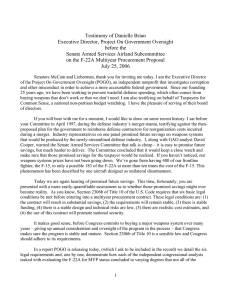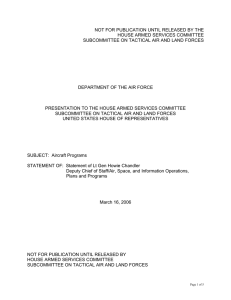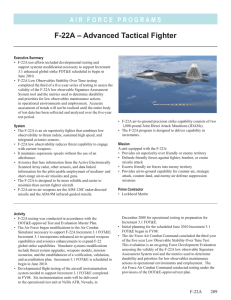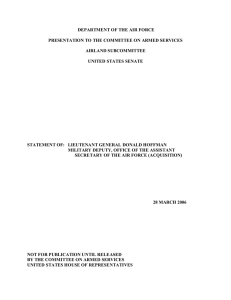Document 11055785
advertisement
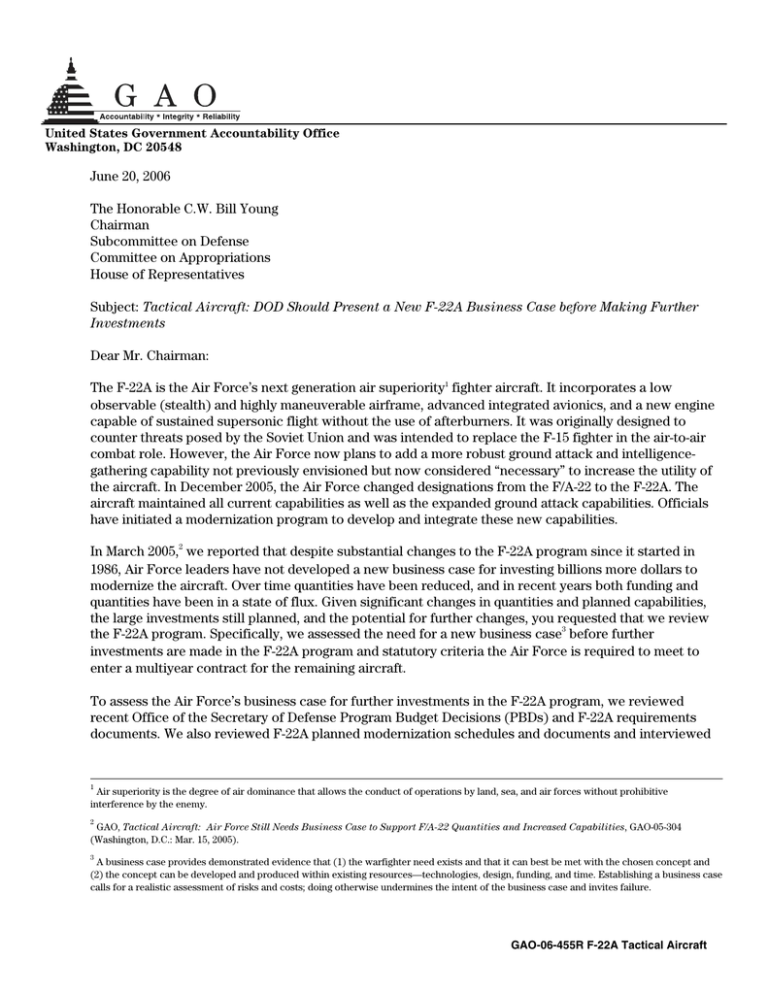
United States Government Accountability Office Washington, DC 20548 June 20, 2006 The Honorable C.W. Bill Young Chairman Subcommittee on Defense Committee on Appropriations House of Representatives Subject: Tactical Aircraft: DOD Should Present a New F-22A Business Case before Making Further Investments Dear Mr. Chairman: The F-22A is the Air Force’s next generation air superiority1 fighter aircraft. It incorporates a low observable (stealth) and highly maneuverable airframe, advanced integrated avionics, and a new engine capable of sustained supersonic flight without the use of afterburners. It was originally designed to counter threats posed by the Soviet Union and was intended to replace the F-15 fighter in the air-to-air combat role. However, the Air Force now plans to add a more robust ground attack and intelligencegathering capability not previously envisioned but now considered “necessary” to increase the utility of the aircraft. In December 2005, the Air Force changed designations from the F/A-22 to the F-22A. The aircraft maintained all current capabilities as well as the expanded ground attack capabilities. Officials have initiated a modernization program to develop and integrate these new capabilities. In March 2005,2 we reported that despite substantial changes to the F-22A program since it started in 1986, Air Force leaders have not developed a new business case for investing billions more dollars to modernize the aircraft. Over time quantities have been reduced, and in recent years both funding and quantities have been in a state of flux. Given significant changes in quantities and planned capabilities, the large investments still planned, and the potential for further changes, you requested that we review the F-22A program. Specifically, we assessed the need for a new business case3 before further investments are made in the F-22A program and statutory criteria the Air Force is required to meet to enter a multiyear contract for the remaining aircraft. To assess the Air Force’s business case for further investments in the F-22A program, we reviewed recent Office of the Secretary of Defense Program Budget Decisions (PBDs) and F-22A requirements documents. We also reviewed F-22A planned modernization schedules and documents and interviewed 1 Air superiority is the degree of air dominance that allows the conduct of operations by land, sea, and air forces without prohibitive interference by the enemy. 2 GAO, Tactical Aircraft: Air Force Still Needs Business Case to Support F/A-22 Quantities and Increased Capabilities, GAO-05-304 (Washington, D.C.: Mar. 15, 2005). 3 A business case provides demonstrated evidence that (1) the warfighter need exists and that it can best be met with the chosen concept and (2) the concept can be developed and produced within existing resources—technologies, design, funding, and time. Establishing a business case calls for a realistic assessment of risks and costs; doing otherwise undermines the intent of the business case and invites failure. GAO-06-455R F-22A Tactical Aircraft program officials from the F-22A program office, Air Combat Command, and the Air Force Program Executive Officer for Tactical Air. To assess the Air Force’s proposed use of a multiyear contract for the remaining F-22As, we compared program documentation on cost, schedule, and performance with statutory criteria for entering into a multiyear contract. We conducted our review between August 2005 and April 2006 in accordance with generally accepted government auditing standards. Summary Based on our review, in our opinion, the DOD has not demonstrated the need or value for making further investments in the F-22A program. The Air Force’s current stated “need” is for 381 F-22As to satisfy airto-air missions and recently added requirements for more robust ground attack and intelligencegathering capabilities. However, because of past cost overruns and current budget constraints, the Office of the Secretary of Defense (OSD) states that it can now afford only 183 F-22As. This leaves a 198-aircraft gap between the Air Force’s stated need and what is currently affordable. The Air Force is planning to invest about $4.4 billion through 2011 to add more robust ground attack and intelligence gathering capabilities for the F-22A. However, because of the large aircraft gap between stated Air Force requirements and current and future budget realities, it may not be prudent to make additional investments for these new missions and capabilities. Furthermore, alternatives such as the Joint Strike Fighter and F-15 might be able to execute ground attack more cost-effectively given the substantially fewer numbers of F-22As that OSD has committed to buy. In December 2005, OSD restructured the F-22A program by extending production to 2010, adding 4 aircraft for a total planned procurement of 183 F-22As and adding $1 billion to the procurement program. Under the restructured acquisition program, the Air Force is planning to procure a total of 60 F-22As in a multiyear procurement. However, in the Air Force’s multiyear procurement justification package sent to Congress on May 16, 2006, it stated that an additional $674 million is needed to fully fund the multiyear program being proposed. Our work led us to make observations on issues that could affect the Air Force’s ability to satisfy several of the statutory criteria for entering into a multiyear contract, including the documentation of savings, a stable design, and available funding. We believe the Congress should consider withholding additional funding for procurement and modernization until the Department completes a comprehensive business case that addresses the concerns we have raised herein. In response to a draft of this report, the Department stated that a recently completed Joint Air Dominance (JAD) study conducted by DOD adequately identified the quantity and mix of tactical aircraft needed and thus already satisfied the intent of our recommendation. We have asked OSD to provide us access to the JAD study, but it has not yet done so. We plan to pursue this matter with the Department. However, because Congressional deliberations on this issue are ongoing, we believe it is important to provide the data and analysis in the report at this time. Given the way this program has unfolded, with frequently changing OSD-approved requirements, repeated cost overruns, and given that DOD did not object to the data and analysis contained in the report, we are not changing our matter for Congressional consideration. If Congress does decide to provide more funding for the F-22A program, that funding should be conditioned on DOD providing the JAD study and subjecting it to independent review to ensure that it provides adequate justification for sound investment of taxpayer resources. Background The F-22A began development in 1986 to replace the F-15 air superiority aircraft. The continued need for the F-22A, the quantities required, and modification costs to perform its mission have been the subject of a continuing debate within DOD and the Congress. Supporters cite its advanced features— Page 2 GAO-06-455R F-22A Tactical Aircraft stealth, supercruise speed, maneuverability, and integrated avionics—as integral to the Air Force’s Global Strike initiative and for maintaining air superiority over potential future adversaries.4 Critics argue that the Soviet threat the fighter was originally designed to counter no longer exists and that its remaining budget dollars could be better invested in enhancing current air assets and acquiring new and more transformational capabilities that will allow DOD to meet evolving threats. The Air Force has already committed funds to acquire 122 F-22As. To complete the procurement program, it now plans to buy the remaining F-22As using a 3-year multiyear contract that ends procurement in 2010. To begin the multiyear strategy, the Air Force has included $2.0 billion for advance procurement of parts and subassembly activities in its fiscal year 2007 budget request. Additionally, it has included $800 million for continuing development and modifications of existing aircraft. DOD Has Not Completed a New Business Case to Justify Further Investments in the F-22A Program The Air Force’s business case for the F-22A program is unexecutable as planned because there is a significant mismatch between the Air Force’s stated “need” for the F-22A aircraft and the resources OSD is willing to commit. According to Air Force officials, a minimum of 381 F-22A aircraft are needed to satisfy today’s national security requirements, yet OSD states it can only afford to buy 183 F-22A aircraft. This results in a 198-aircraft gap in capability. Additionally, the Air Force now states a “need” for greater ground attack and intelligence-gathering capabilities, not included in the existing business case that will require an extensive modernization program. The value of this planned investment in modernization is highly questionable absent a new business case that supports the minimum capability-based need, given credible current and future threats, and that considers various options that are both affordable and sustainable over time. The Air Force states a need for one squadron of 24 F-22A aircraft for each of the 10 Air Expeditionary Forces, the planned organization of the Air Force aircraft and personnel for operations and deployments. This requirement is established to carry out missions including support in major regional conflicts, home land security, and others. According to the Air Force, this requires a total of 381 F-22As, 240 primary aircraft and 141 aircraft for training, attrition, and to allow for periodic aircraft depot maintenance. OSD has restructured the F-22A acquisition program twice in the last 2 years (in December 2004 and December 2005) to free up funds for other priorities. These decisions have created a mismatch between the Air Force’s stated requirements and what OSD considers an affordable quantity of F-22As. In December 2004, OSD reduced the program to 179 F-22As to save about $10.5 billion. This budget decision also terminated procurement in 2008. Then in December 2005, OSD changed the F-22A program th again, adding $1 billion to extend production for 2 years to ensure a 5 generation fighter5 aircraft production line would remain in operation in case the Joint Strike Fighter experienced delays or problems. OSD also added 4 aircraft for a total planned procurement of 183 F-22As. The Air Force is currently planning to provide the F-22A with greater ground attack and intelligencegathering capabilities. It estimates these will cost about $4.4 billion between 2005 and 2011. It is also 4 Global Strike is one of six complementary concepts of operations laying out the Air Force’s ability to rapidly plan and deliver limited-duration and extended attacks against targets. 5 th F-22A and F-35 are considered 5 generation fighter aircraft as compared to the F-15, F-16, F/A-18 and F-117. The primary characteristics are th Very Low Observable (VLO) stealth and information fusion capabilities that make 5 generation aircraft more survivable and lethal. Page 3 GAO-06-455R F-22A Tactical Aircraft planning additional modernization efforts for more of these capabilities in the future, but the cost, content, and timing has not yet been determined. However, the 198- aircraft gap between the Air Force’s stated “requirement” and the planned procurement quantities raises questions on whether the F-22A will be able to carry out its planned missions. The Air Force is buying less than half the required 381 aircraft to fill out its planned organizational structure—necessary to carry out planned air-to-air, ground attack, and intelligence-gathering missions. Other alternatives could be available to carry out the ground attack and intelligence gathering capabilities. For example, DOD is also investing billions of dollars to develop th the Joint Strike Fighter aircraft—a 5 generation fighter-intended for ground attack and billions of dollars to develop intelligence, surveillance, and reconnaissance platforms and sensors. Air Force Is Requesting to Use a Multiyear Contract for the F-22A The Air Force is proposing to buy the remaining 60 F-22As over a 3 year period with a multiyear contract and submitted its justification to the Congress on May 16, 2006.6 To enter into a multiyear contract the Air Force must first meet the statutory criteria listed in 10 U.S.C. § 2306b (a). Table 1 shows the six criteria that must be satisfied before entering into a multiyear contract and our observations on issues that could affect the Air Force’s ability to satisfy several of the criteria. 6 The Air Force needs statutory authorization for its proposed multiyear contract under 10 U.S.C. § 2306b and the annual DOD appropriations act. Page 4 GAO-06-455R F-22A Tactical Aircraft Table 1: Observations of F-22A Multiyear Contract Criteria as of April 2006 Multiyear criteria Contract will result in substantial savings Minimum need expected to remain substantially unchanged during contract period in terms of production rates and total quantities Reasonable expectation agency head will request funding at required level to avoid contract cancellation There is stable design, and technical risks are not excessive Estimates of contract cost and cost avoidance are realistic Use of contract will promote national security of the United States GAO observations The Air Force has not completed an estimate of savings, but its preliminary indications are a maximum of 5 percent savings. However, when the unit procurement costs for the planned multiyear approach is compared to how the Air Force had previously planned to buy the remaining aircraft, the unit procurement costs increase under multiyear. Quantities have continually been in a state of flux in the F-22A program including changes in the last two budget submissions. The Air Force has indicated that its multiyear budget is currently under funded by $674 million. Further, it is proposing to use incremental funding rather than fully funding each aircraft lot. While the design for the baseline F-22A aircraft, designed primarily for an air superiority role, is stable, the design for the ground attack capability to be added has not been demonstrated and thus cannot be considered “stable.” The Air Force has not completed its analysis of contract cost or cost avoidance at this time. No observation. Source: GAO Analysis and 10 U.S.C. 2306b. The Air Force has requested statutory authorization for a multiyear contract for the remaining F-22As as part of the fiscal year 2007 authorization and budget process in order to award the contract in early 2007. As shown in the table above, we believe there are some critical considerations that need to be addressed before the multiyear plan can be justified. These include the following considerations: Savings—The Air Force stated in its May 16, 2006, multiyear justification package that cost avoidance would approximate $225 million or about 2.7 percent. This is based on comparing three annual contracts to a single multiyear contract to buy 56 aircraft. The document also identifies a need for an additional $674 million to fully fund a 60 aircraft multiyear contract as was proposed in the fiscal year 2007 President’s budget. While building an estimate for three separate annual contracts provides a basis to compare to a multiyear approach, it is not how the Air Force had previously planned to buy the aircraft remaining in the F-22A program. The fiscal year 2006 President’s Budget included procurement costs to buy the remaining 56 F-22As in two lots—29 F-22As in 2007 and 27 F-22As in 2008. If the unit procurement costs of this previous plan are compared to the planned multiyear procurement unit costs for 60 aircraft as proposed in the fiscal year 2007 President’s Budget, the unit costs increase by 10 percent. In other words, the unit procurement costs increase from $166 million per aircraft to $183 million per aircraft for the proposed multiyear contract. Page 5 GAO-06-455R F-22A Tactical Aircraft Funding—The Air Force has stated that the proposed multiyear plan for 60 aircraft is under funded by about $674 million. The Air Force believes it will need these funds in fiscal years 2009 and 2010. Additionally, the Air Force has proposed using incremental funding to pay for the multiyear contract. Instead of fully funding the buy for each fiscal year, it plans four funding increments—economic order quantity, advanced buy, subsystem, and final assembly. Incremental funding for multiyear procurement is neither permitted by the annual DOD appropriations act,7 nor the multiyear authorizing statute which requires that funds only be obligated under a multiyear contract “for procurement of a complete and usable end item.”8 However, the Air Force is seeking an exception to these requirements in its request to Congress for statutory authorization for the multiyear contract. The Air Force’s proposed F-22A multiyear strategy includes an increment of funding in each fiscal year to begin manufacturing subsystems, not considered a complete and useable end item. For example, the fiscal year 2007 budget request includes $1.5 billion for subassemblies. It would not be until fiscal year 2008 that the final assembly would be fully funded. Design Stability—The baseline F-22A aircraft, designed primarily for the air superiority role, has successfully completed development and initial operational testing, and its design is stable for that particular mission. However, the Air Force has stated that to be “effective” in the future a more robust ground attack capability is needed for the F-22A. It plans to spend several billions of additional dollars to add this ground attack capability. A key to the success of this effort is the development and integration of a new radar. The Air Force expects to take delivery of the first aircraft with the new radar in November 2006 but the software needed to provide the robust ground attack capability will not be completed until 2010. According to a representative of the Director, Operational Test and Evaluation (DOT&E), the key to achieving a more robust ground attack capability will center on the integration of this new radar. A December 2005 report issued by the Defense Contract Management Agency stated that problems encountered during the test and integration of the new radar has added risk to the development program. Until software and integration testing in the F-22A have been successfully completed, we consider the design unstable creating the potential for significant cost overruns and schedule delays. Conclusions The F-22A development has spanned more than a 19-year period during which time requirements have changed both in terms of the quantity of aircraft needed and the capabilities that would be incorporated. At the same time, new budgetary constraints have grown and other priorities have come to the forefront in DOD, including the need for funding the war on terrorism. While the Air Force’s stated need is 381 F-22As, OSD will commit to fund only 183. The Air Force also states the basic capabilities developed for the F-22 are not sufficient to be effective in the current and future national security environment. The conditions facing the F-22A program are significantly different than those addressed by the original business case, yet despite these significant changes the Air Force has not developed a new business case to justify currently planned and proposed additional investments in the F-22A. Given our nation’s growing fiscal challenges, the changing security threats, and prevailing best business practices for acquisitions, it is highly questionable whether it is prudent to continue in the current path proposed by 7 Section 8008 of the fiscal years 2005 and 2006 Department of Defense Appropriations Acts (Public Laws 108-287 and 109-148, respectively) require full funding of units to be procured. 8 10 U.S.C. § 2306b (i)(4)(A). This restriction was added by section 820 of the Bob Stump National Defense Authorization Act for Fiscal Year 2003 (Public Law 107-314). Page 6 GAO-06-455R F-22A Tactical Aircraft the Air Force. DOD must begin to make the difficult choices required to counter current and credible future threats at current and expected future resource levels because it will not have enough money to purchase everything that it wants. Furthermore, going to a multiyear procurement strategy appears to be more costly than previous Air Force plans and would tie up significant amounts of funds at a time when DOD already has more wants than it is likely to be able to afford and sustain over time. The Department needs to reevaluate the value delivered by continuing production of the F-22A past what it has already committed to by examining the likely future threat and risk environment, the funding it can make available relative to other demands, and the alternative ways to achieve air-to-air and air-to-ground military superiority. Matters for Congressional Consideration Because of the large disparity between what the Air Force wants for the F-22A program and what OSD has committed to fund, there is a significant break in the business case to justify buying more F-22As. For this reason, Congress may want to consider withholding additional funding for procurement and modernization until the Department completes a comprehensive business case that addresses the concerns we have raised herein. The additional issues surrounding this matter and our reporting are discussed in the Agency Comment section of this report. Recommendation Because of the significant and continuing changes in the F-22A program that have created an environment of investment uncertainty as well as the significant mismatch between stated Air Force needs and wants and future resource levels, we recommend that Secretary of Defense delay further investments in F-22A procurement and modernization until it completes a comprehensive business case analysis that adequately considers alternatives, justifies the need for further investments, and reconciles the numbers of F-22As that are needed (i.e. based on credible current and future threats and considering other alternative approaches) as well as affordable and sustainable (i.e., based on current and expected DOD resource levels). Agency Comments and Our Evaluation In written comments on a draft of this report, DOD stated that it did not concur with our recommendation that the Secretary of Defense delay further investments in F-22A procurement and modernization until it completes a new business case analysis that adequately considers alternatives, justifies the need for further investments, and reconciles the numbers of F-22As that are needed. They stated a Joint Air Dominance (JAD) study conducted by DOD adequately identified the quantity and mix of tactical aircraft needed. DOD stated that delaying investments in the F-22A would disrupt production and create program instability. DOD also stated that keeping the F-22A production line active, preserves the Department’s options and sustains the industrial base for efficient transition to Joint Strike Fighter production. Preserving options and the industrial bases will be costly. The 2007 future year’s defense plan added $1.05 billion for a 60 aircraft multiyear procurement contract and subsequently the Air Force identified an additional $674 million needed to fully fund this plan. Therefore, the total additional multiyear procurement cost is $1.724 billion. Furthermore, it will add two years to the F-22A procurement program. This represents significant opportunity cost. That is, the funding used here will not be available to support other DOD priorities. If preserving options and the industrial base are primary reasons for these added costs and the extension of the procurement program, DOD should make them more transparent to the Congress as it seeks authorizations and appropriations to execute this plan. Page 7 GAO-06-455R F-22A Tactical Aircraft As to the Department's position that they have already conducted the business case called for in our recommendation, we asked OSD to provide us access to the JAD study, but they have not yet done so. Because Congressional deliberations are ongoing, we believe it is important to provide the data and analysis in the report at this time. Given the way this program has unfolded, with frequently changing OSD-approved requirements, repeated cost overruns, and delays in fielding capability to the warfighter, and given that DOD did not object to the data and analysis contained in the report, we are not changing our matter for Congressional consideration. If Congress does decide to provide more funding for the F-22A program, that funding should be conditioned on DOD providing the JAD study and subjecting it to independent review to ensure that it provides adequate justification for sound investment of taxpayer resources. - - - - - We are sending copies of this report to the Secretary of Defense; the Director, Office of Management and Budget; and interested congressional committees. We will also make copies available to others upon request. In addition, the report will be available at no charge on the GAO Web site at http://www.gao.gov. Should you or your staff have any questions on matters discussed in this report, please contact Michael Sullivan on (202) 512-4163 or Michael Hazard on 937-258-7917. Principal contributors to this report were Marvin Bonner and Daniel Chen. Sincerely David M. Walker Comptroller General Of the United States Enclosure Page 8 GAO-06-455R F-22A Tactical Aircraft Enclosure Comments from the Department of Defense Page 9 GAO-06-455R F-22A Tactical Aircraft Page 10 GAO-06-455R F-22A Tactical Aircraft Page 11 GAO-06-455R F-22A Tactical Aircraft (120558) Page 12 GAO-06-455R F-22A Tactical Aircraft Enclosure Page 13 GAO-06-455R F-22A Tactical Aircraft
